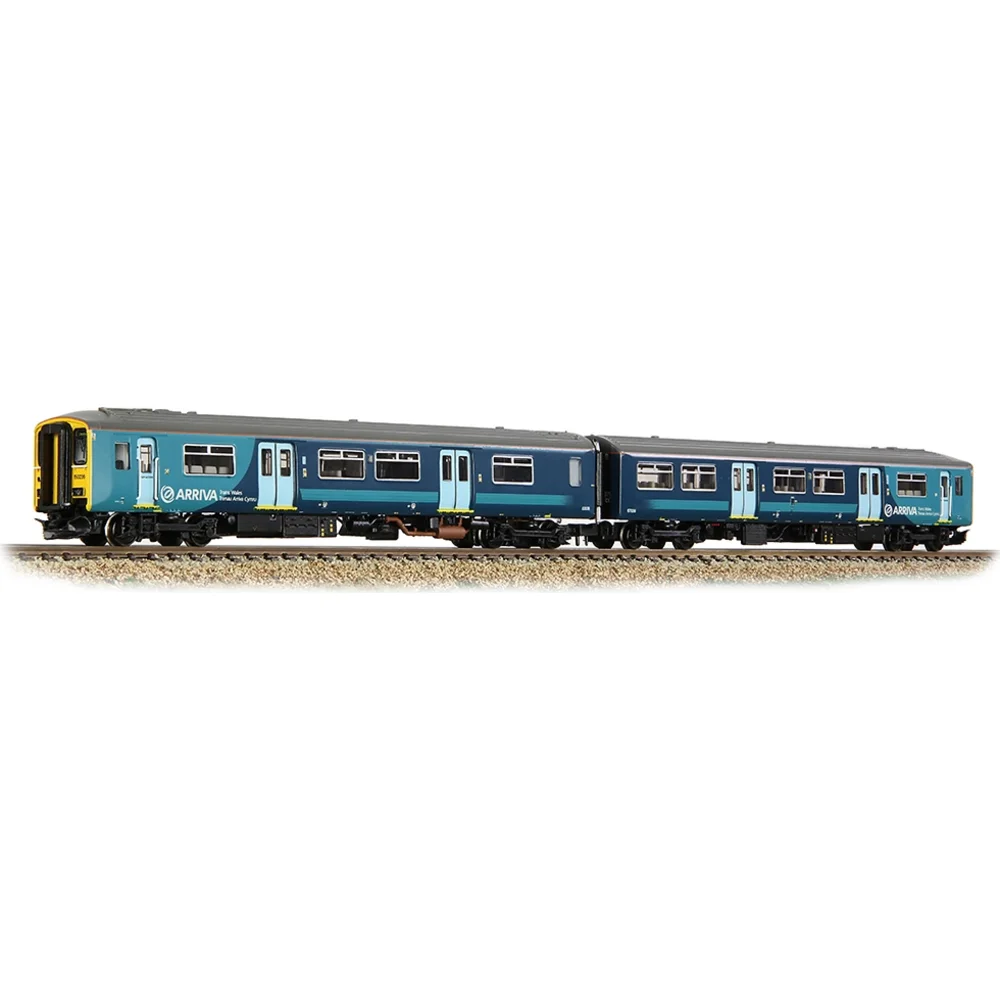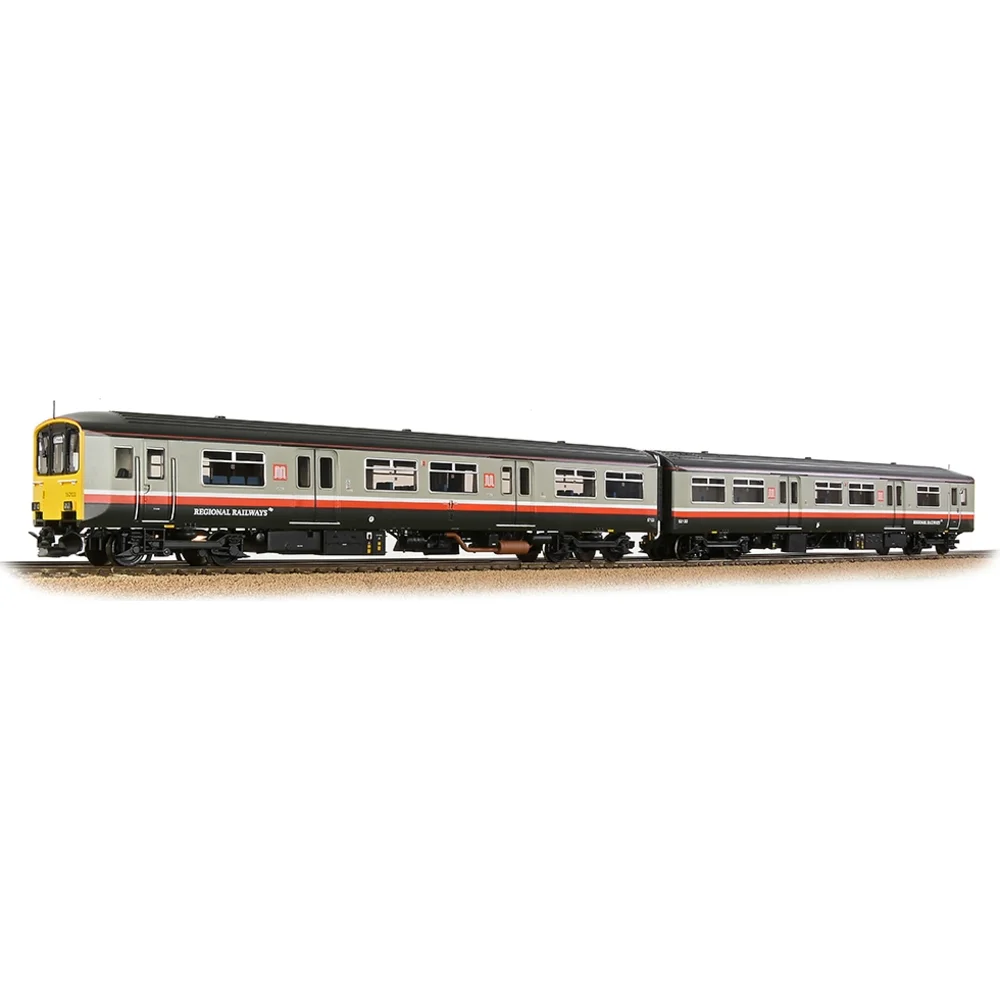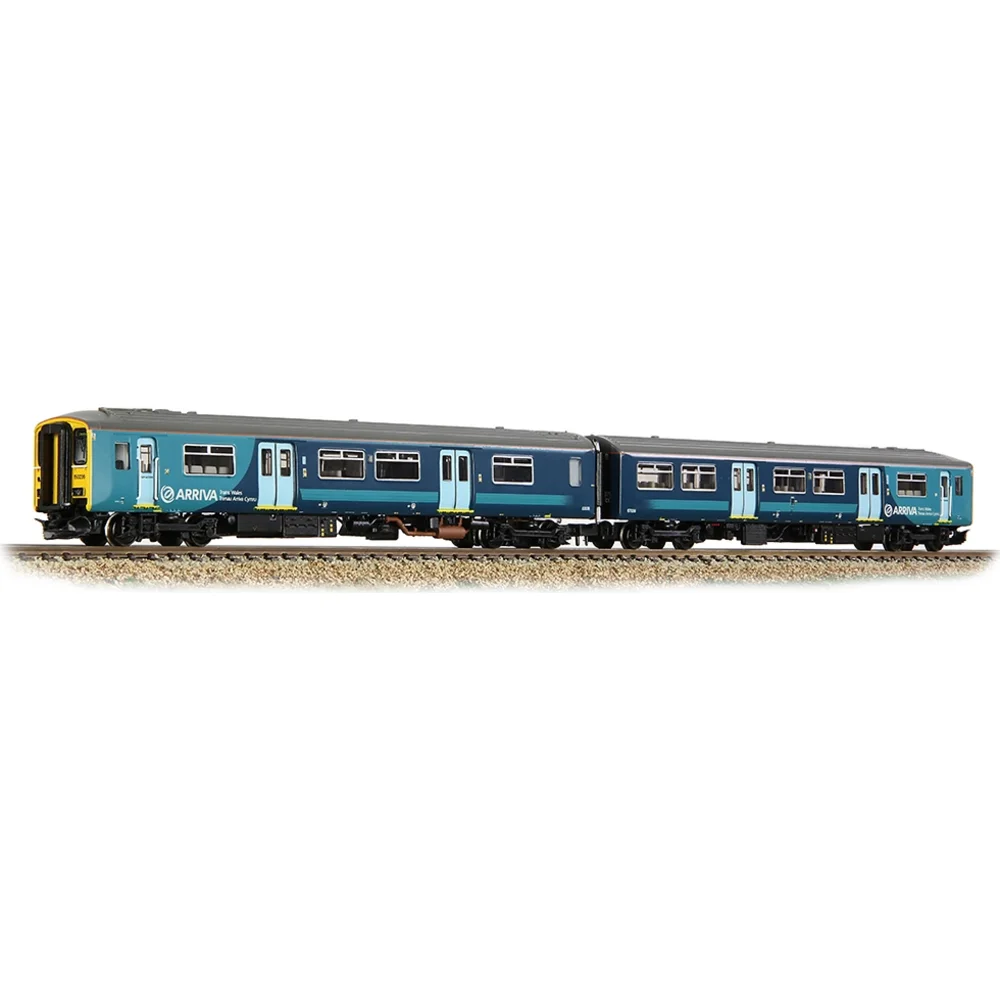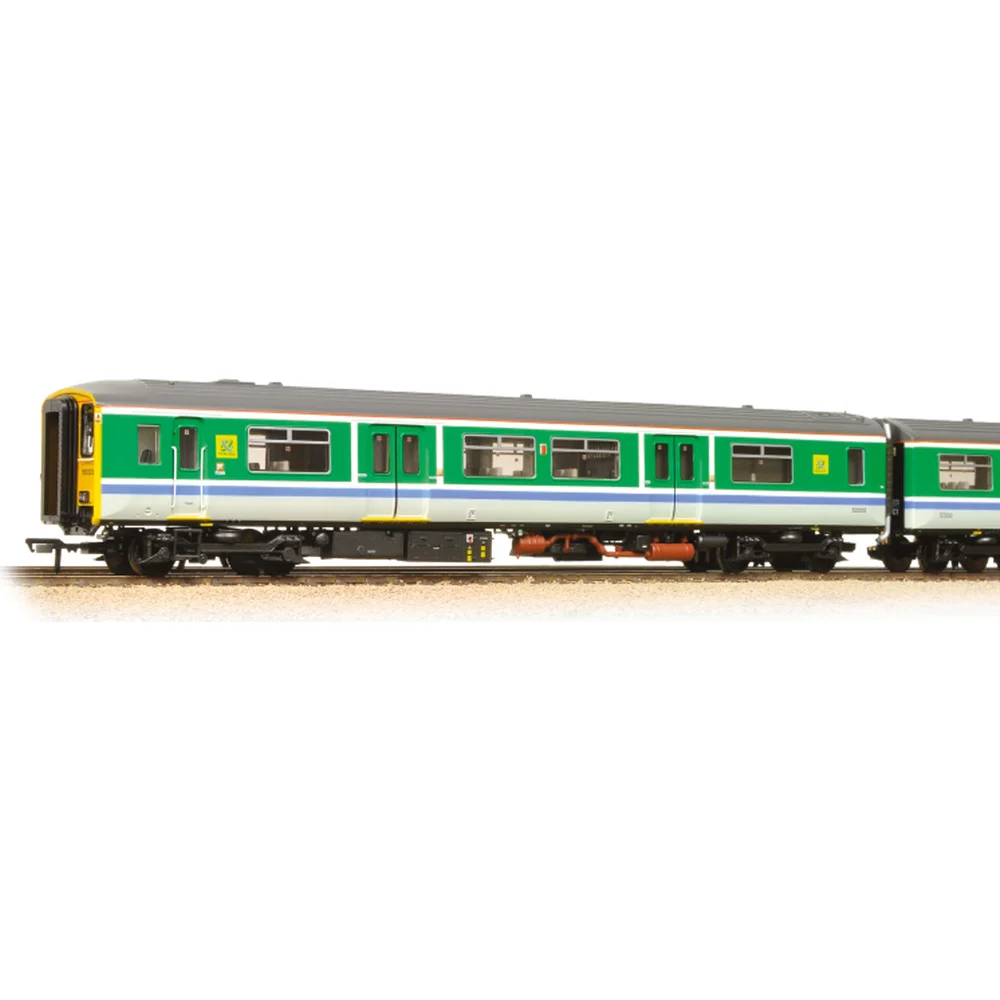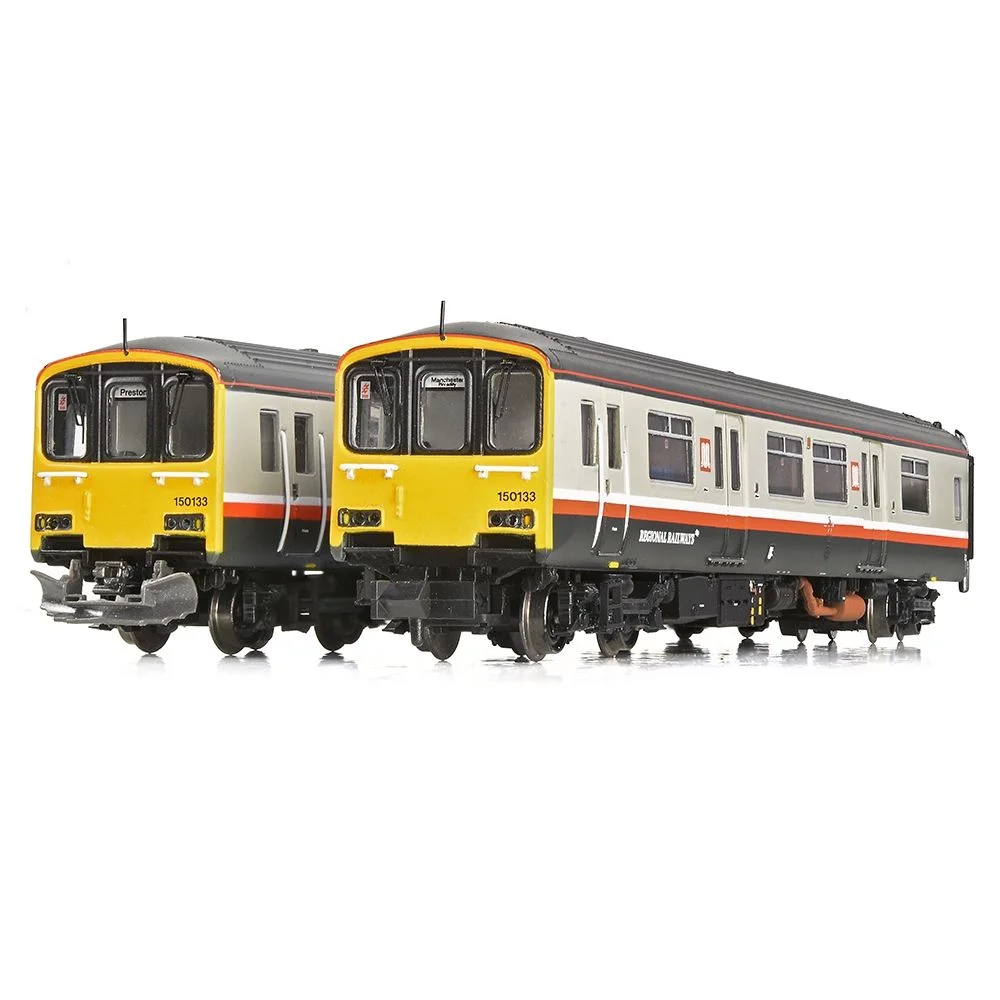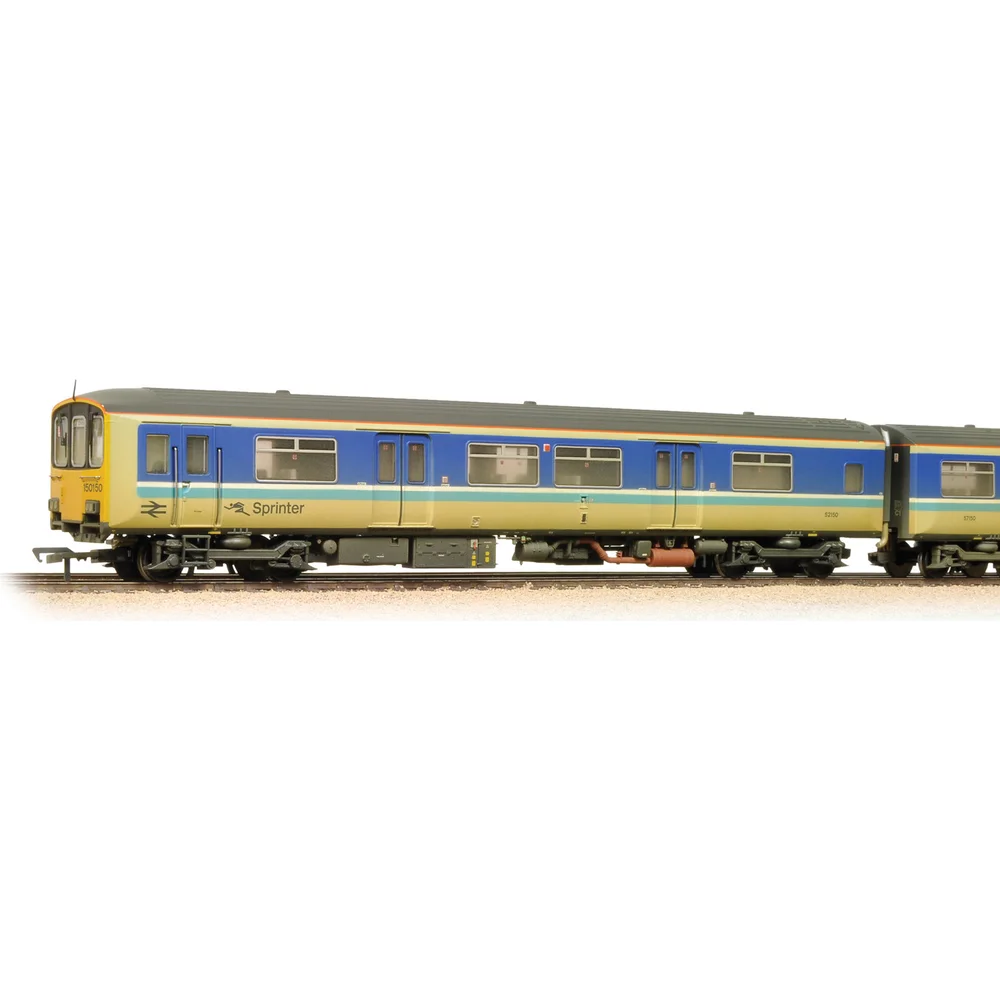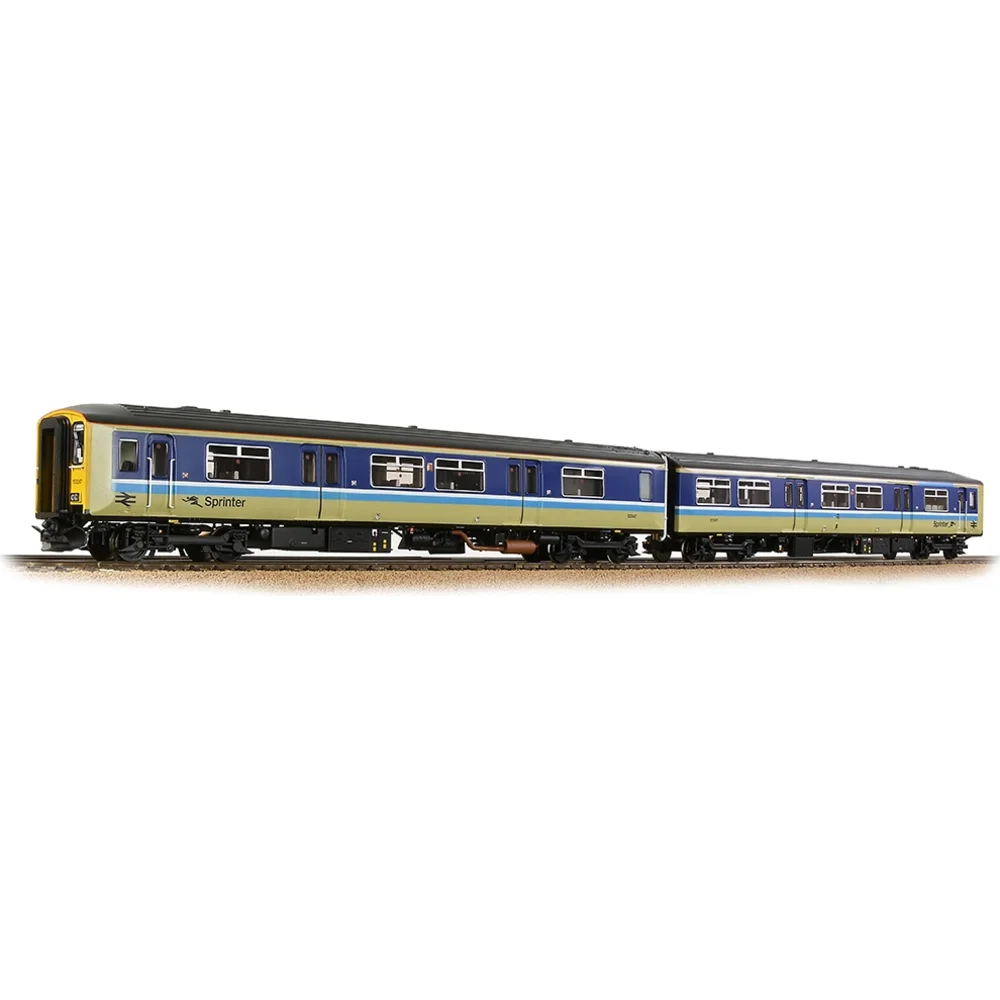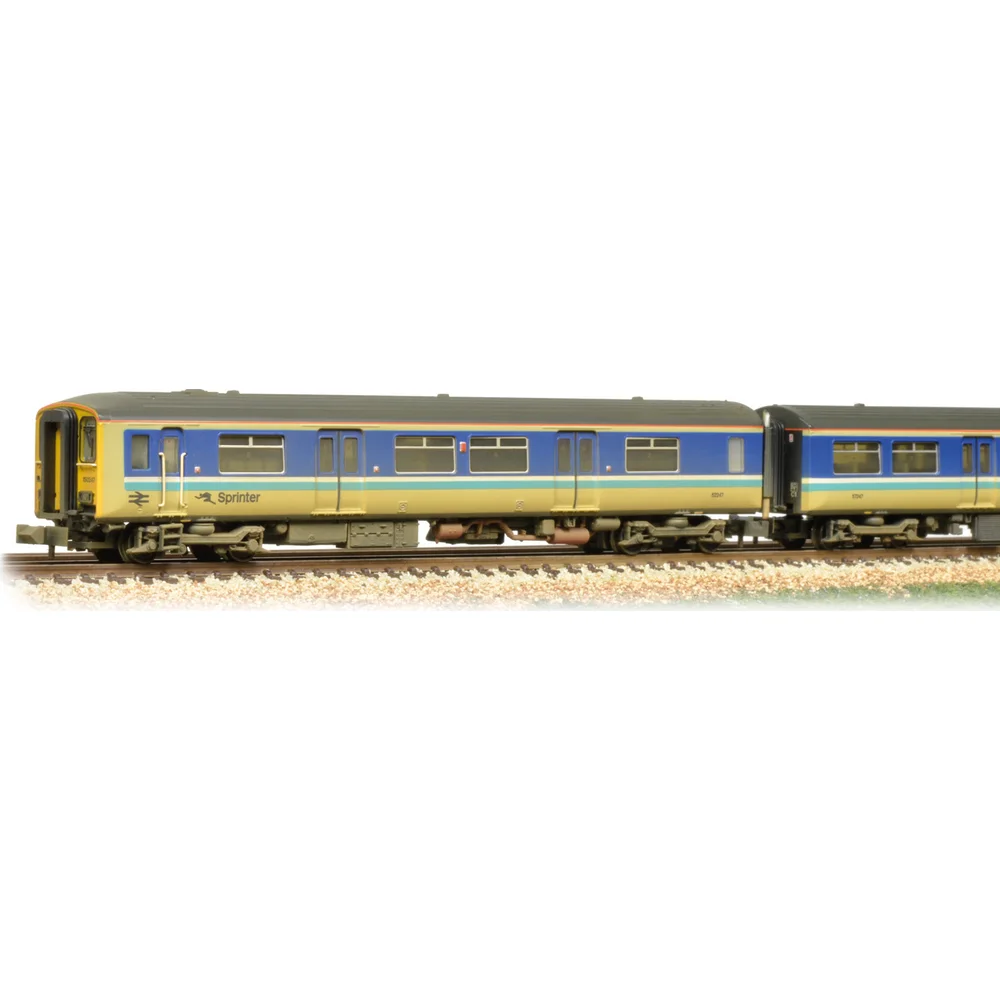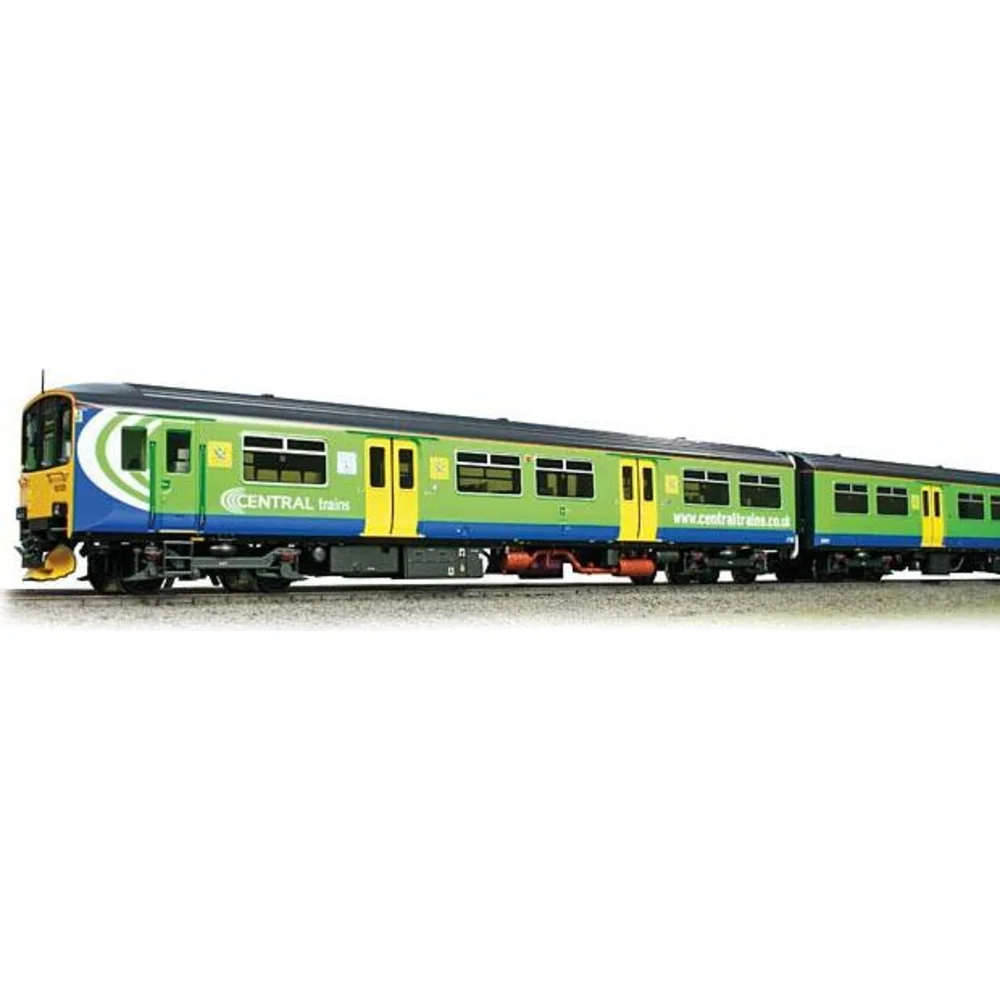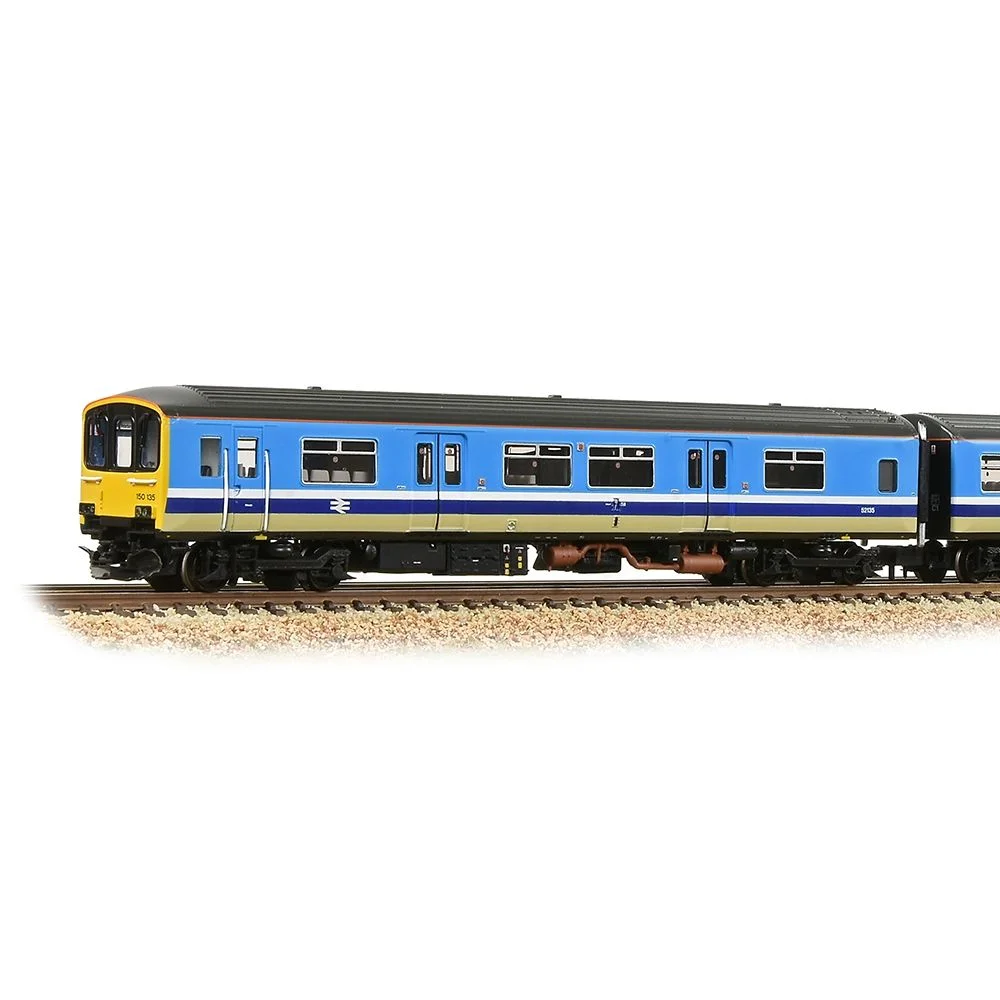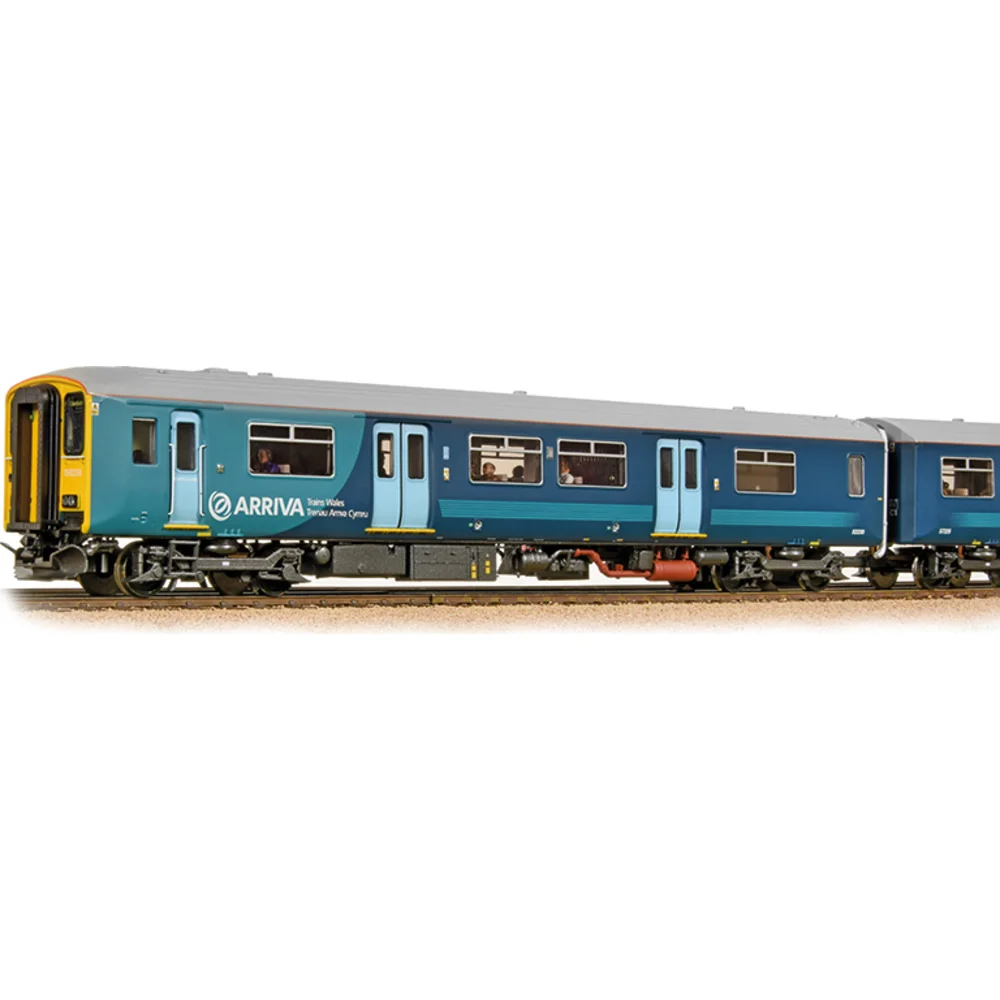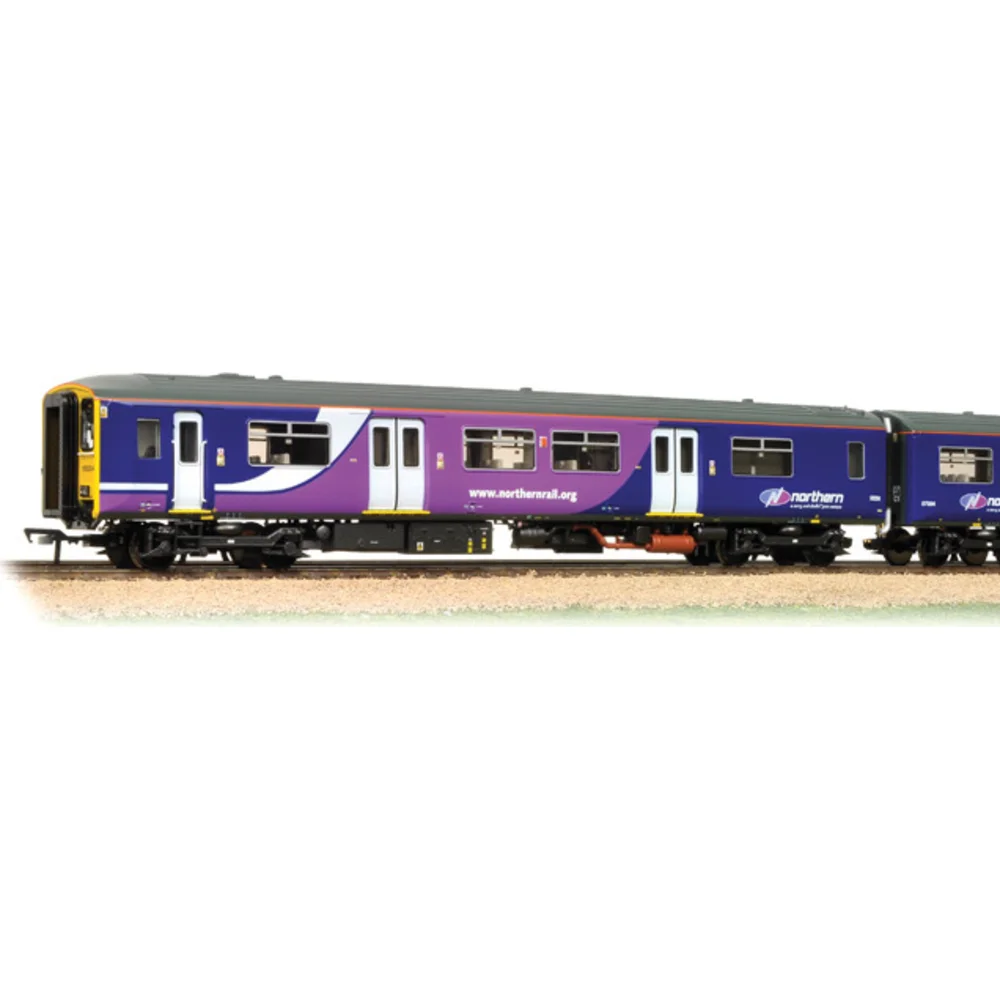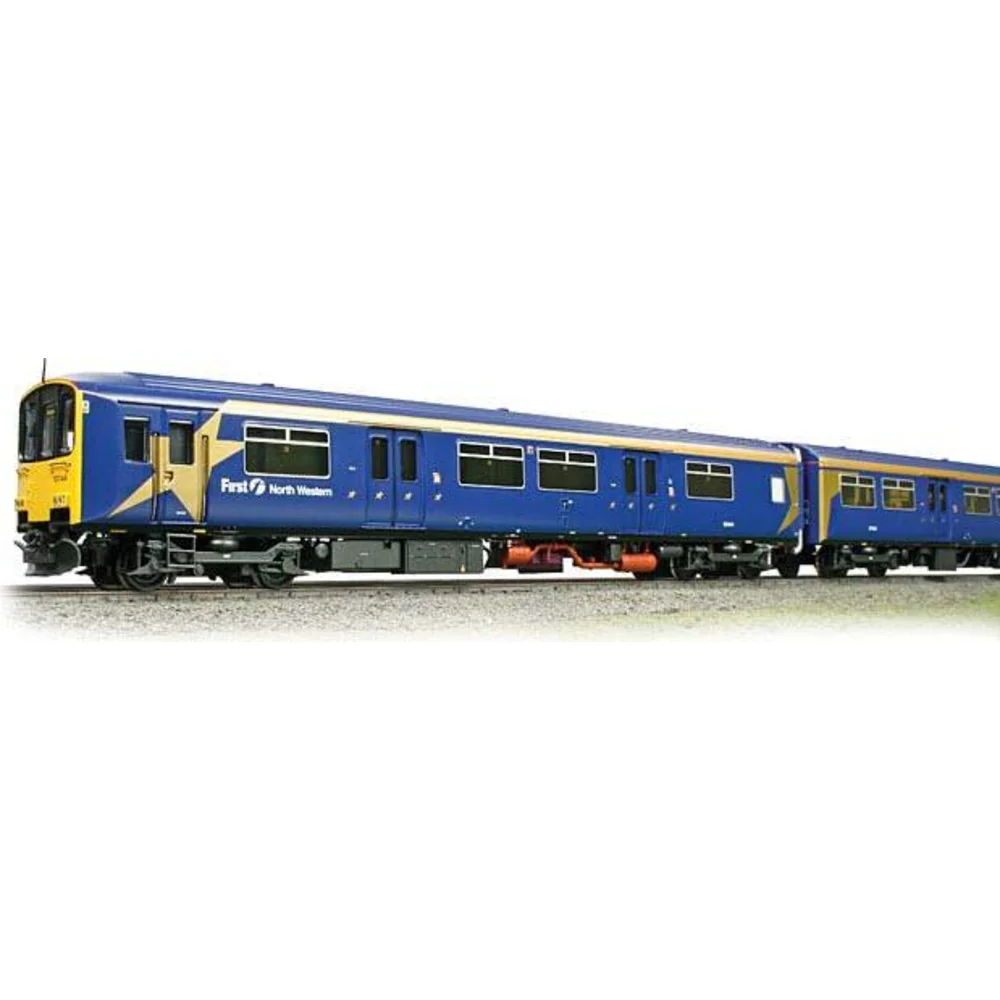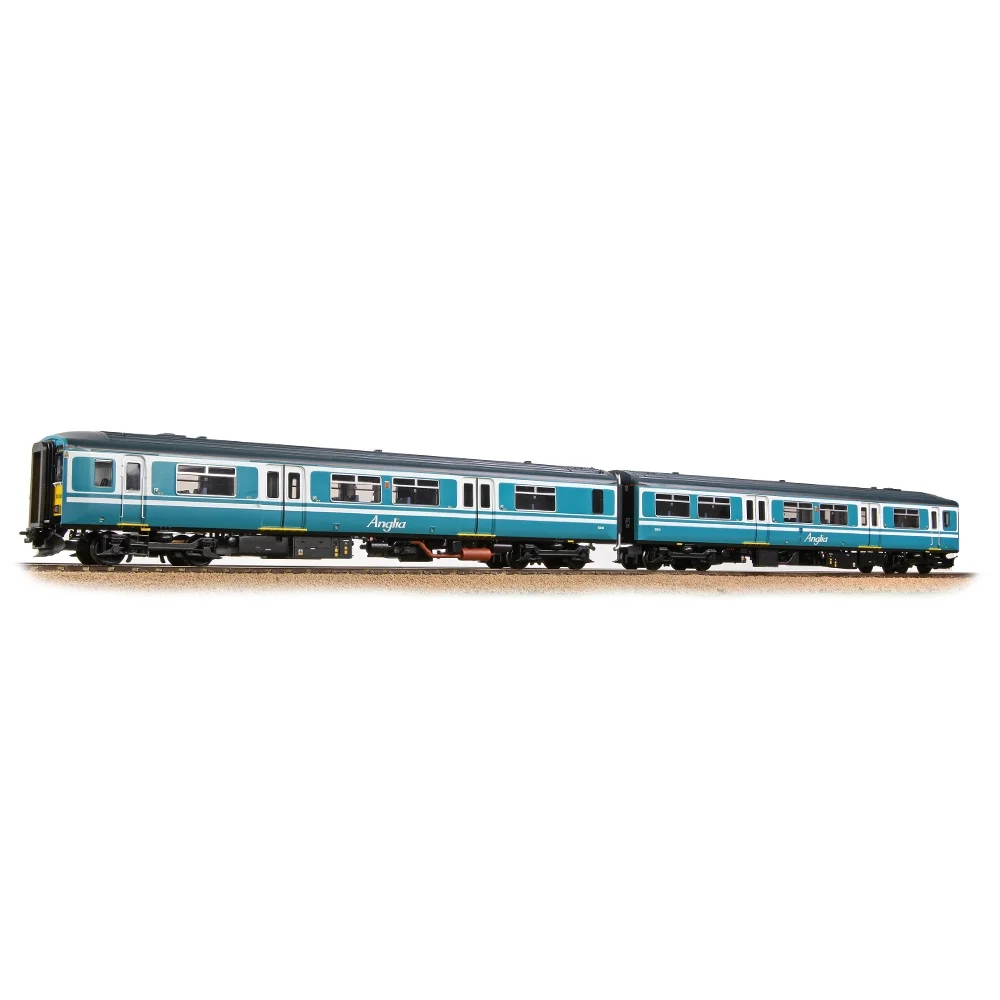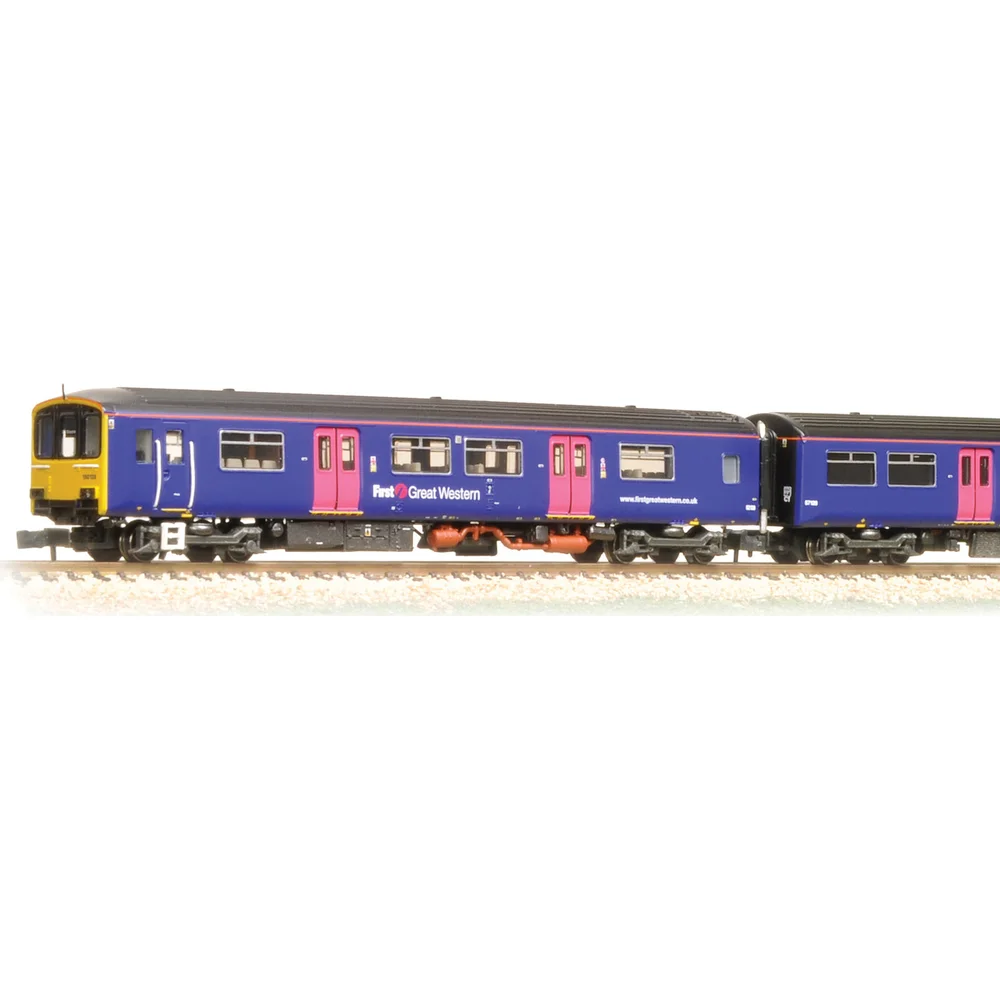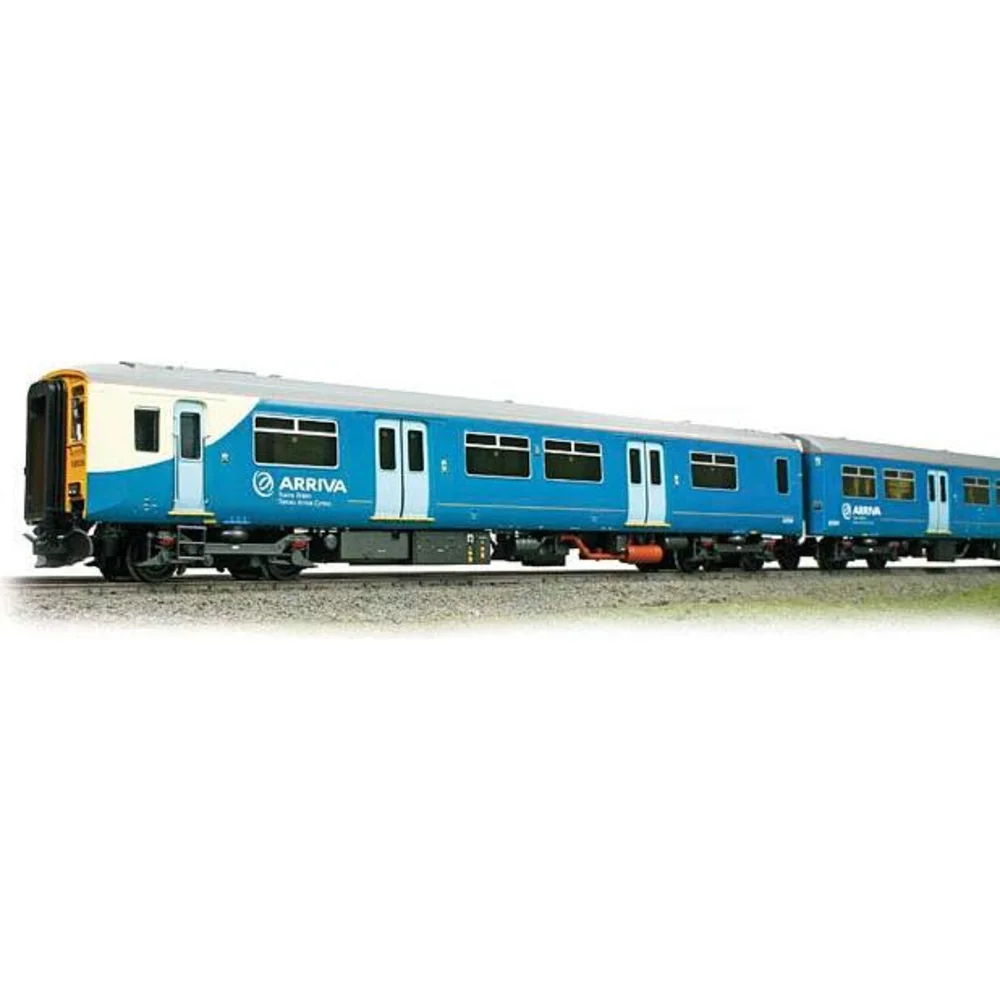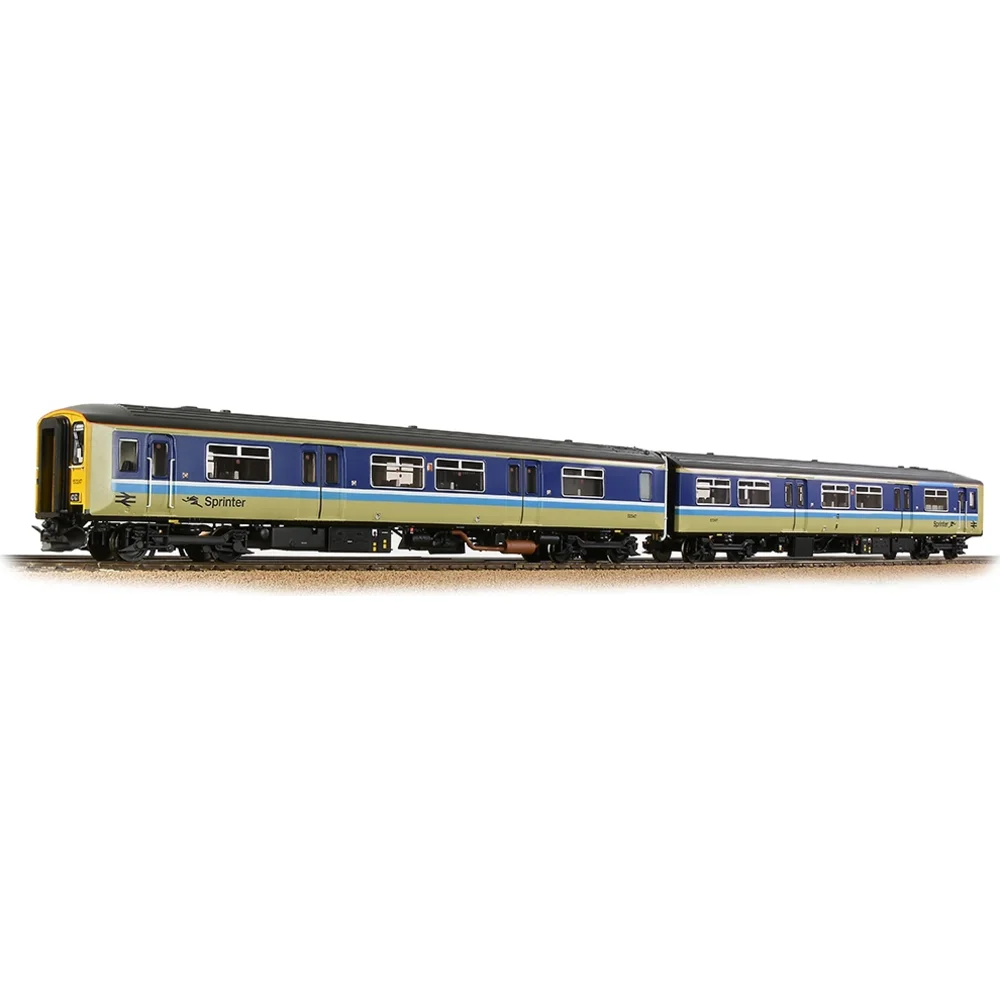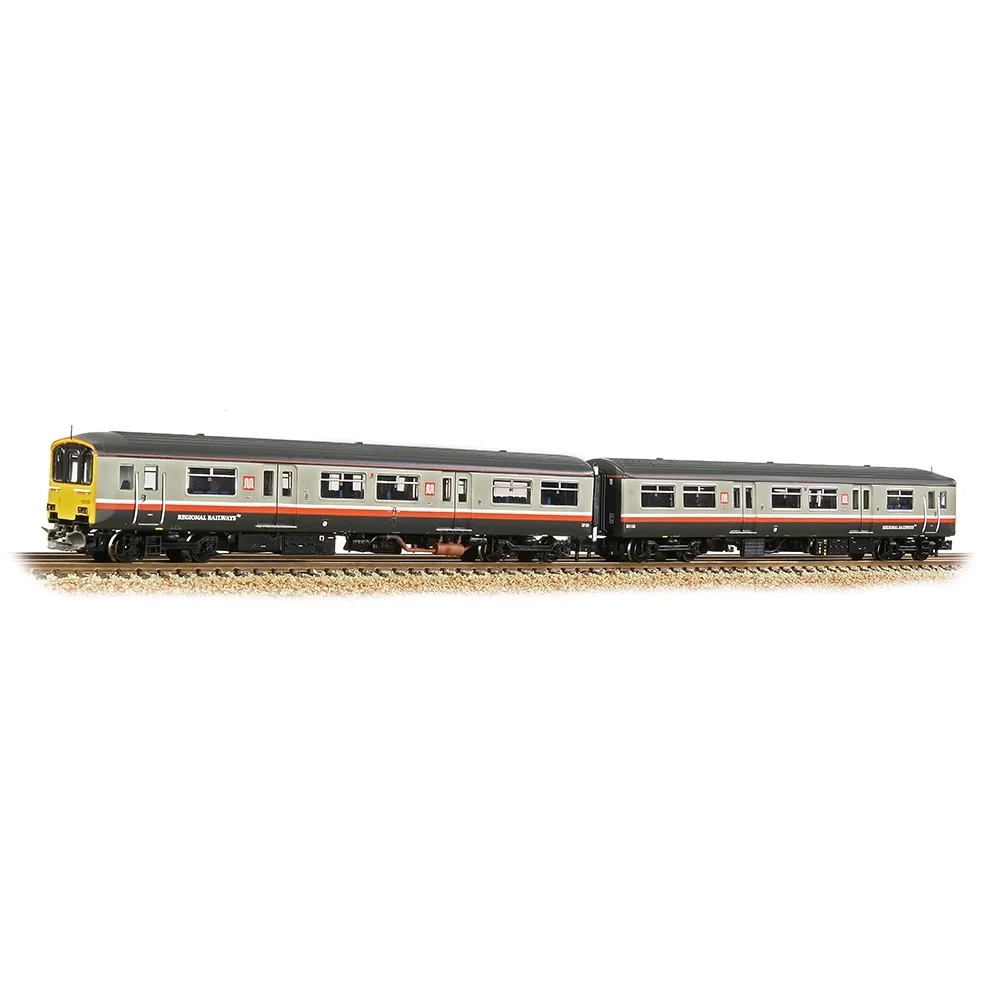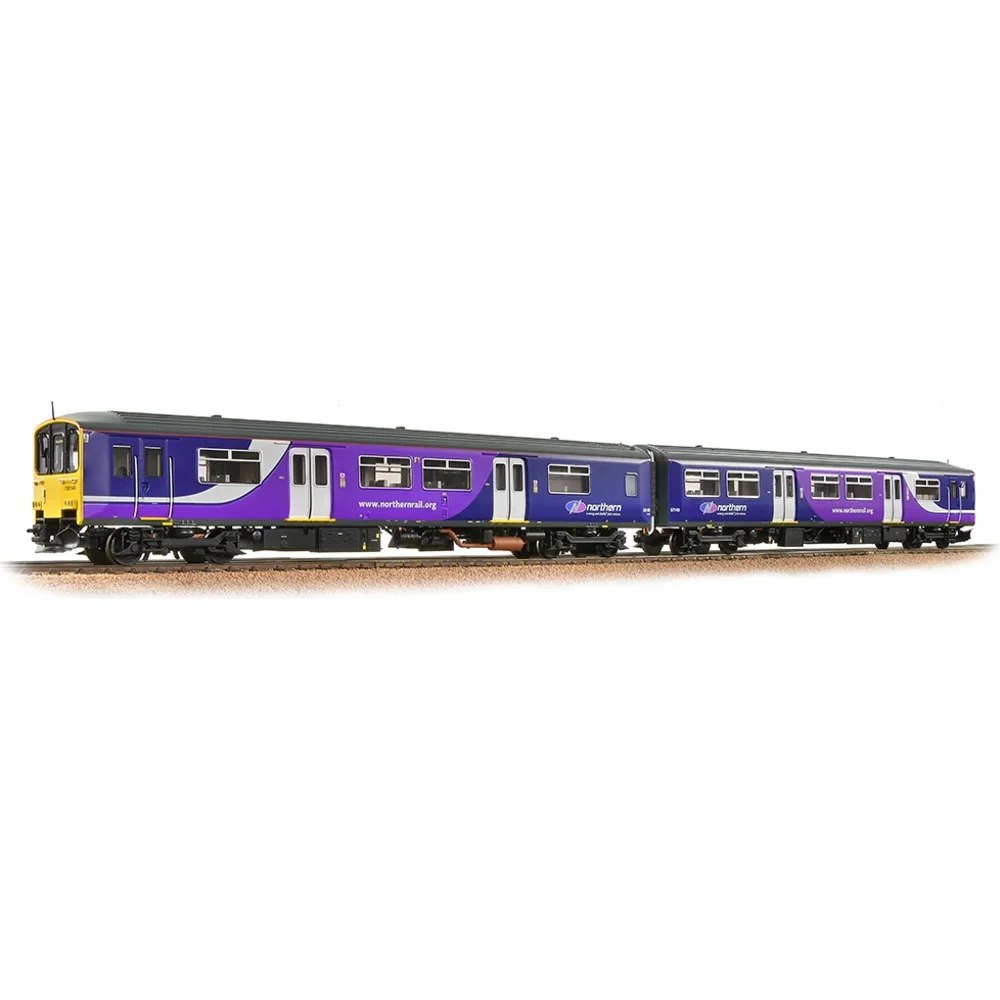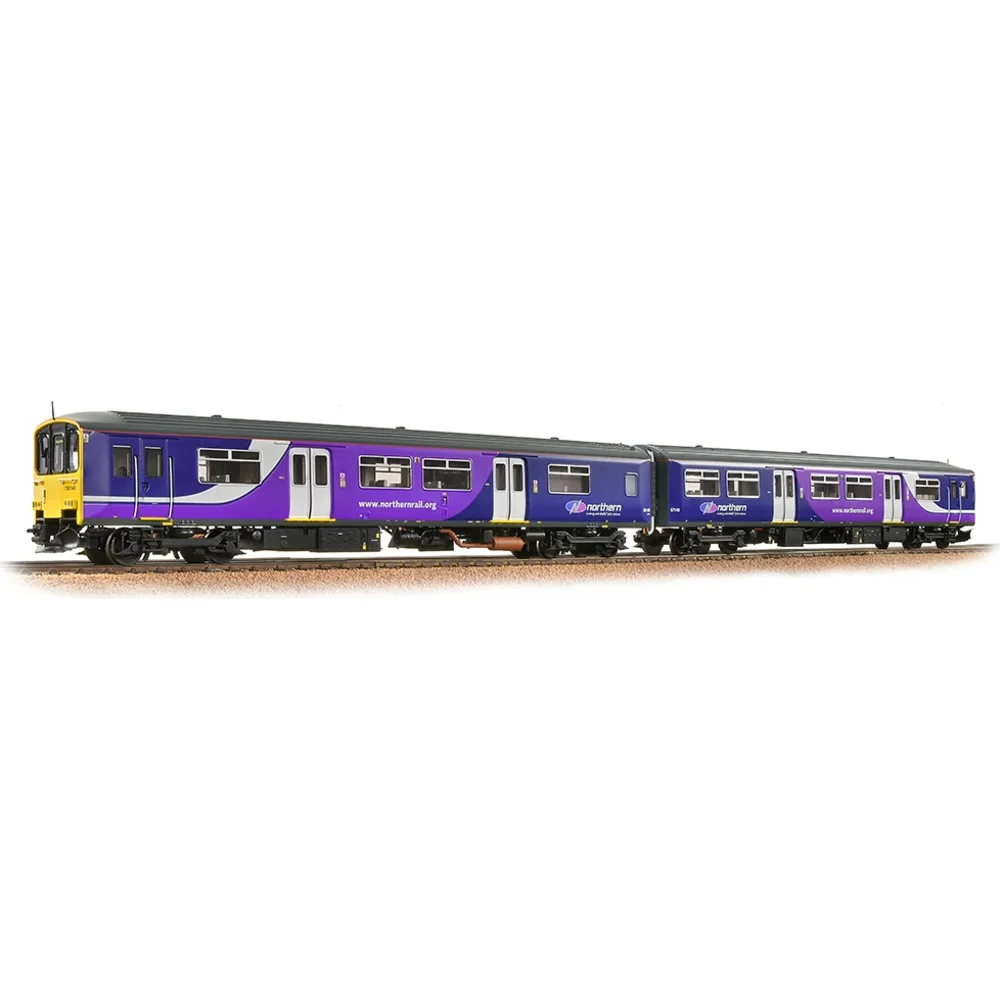British Rail Class 150 – Pioneering Sprinter DMUs that Revolutionised Regional Rail
Contents
The British Rail Class 150 Sprinter represents a watershed moment in railway modernisation. Introduced between 1984 and 1987, these diesel multiple units swept away decades of aging first-generation DMUs and ushered in a new era of comfortable, efficient regional rail travel across Britain. For modellers, they offer exceptional versatility—operating everywhere from Welsh valley lines to Devon branches, from Manchester commuter routes to Scottish rural services.
What makes the Class 150 particularly significant is its role as the foundation stone of the entire Sprinter family. When unit 150001 entered passenger service on the Matlock branch on 19 November 1984, it launched a revolution that would spawn Classes 153, 155, 156, 158, and 159. The Class 150's proven Cummins-Voith powertrain combination became the industry standard, whilst its innovative single-engine-per-car philosophy dramatically reduced maintenance costs compared to earlier designs.
For today's railway enthusiast and modeller, the Class 150 remains highly relevant. After an impressive 40+ years of service, approximately 120-130 units continue revenue-earning operations with Northern Trains, Great Western Railway, Transport for Wales, and London Northwestern Railway. This longevity, combined with the extensive range of liveries worn throughout privatisation, makes them essential additions to any British railway layout from the 1980s through to 2025. Bachmann's comprehensive OO gauge range and Graham Farish's expanding N gauge offerings provide modellers with detailed, DCC-ready replicas in multiple authentic liveries.
Quick Takeaways
- Total built: 137 units comprising 2 three-car prototypes (150/0), 50 two-car 150/1 units, and 85 two-car 150/2 units by BREL York 1984-1987
- Technical innovation: Revolutionary single engine per car with 50% engine-out capability, using proven Cummins NT855-R5 diesels producing 286hp per vehicle
- Operational highlight: First second-generation DMU in service (150001, 19 November 1984), establishing Sprinter family that transformed regional rail across Britain
- Current status: Approximately 120-130 units remain operational in 2025 with gradual withdrawals underway; first preserved example (150231) donated to Watercress Line July 2025
- Modelling appeal: Bachmann dominates with extensive OO gauge range (£199-350 street price); Graham Farish offers N gauge alternatives; both feature 21-pin DCC Ready options
- Unique insight: Class 150/1 and 150/2 differ visibly—150/2 units feature front gangway connections allowing passenger movement between coupled units, whilst 150/1s do not
- Livery variety: Over 15 different liveries worn including BR Provincial, Regional Railways, Northern, GWR Green, Transport for Wales, First North Western, and multiple privatisation-era schemes
Historical Background and Context
By the early 1980s, British Rail faced a modernisation crisis. The railway operated a vast fleet of first-generation DMUs built during the late 1950s and early 1960s—diverse designs that had served reliably but were now hopelessly outdated. Years of underinvestment left BR struggling with elderly trains featuring vacuum brakes, steam heating, and extensive asbestos that required removal by the end of 1987. Operating losses mounted as maintenance costs spiralled and fuel consumption remained stubbornly high.
BR planners examined whether to refurbish existing stock or develop an entirely new generation of DMUs. The answer came through a two-pronged approach: low-cost "Pacers" using bus components for lightly-used routes, and more substantial "Sprinters" based on BR's proven Mark 3 bodyshell design for longer-distance services. The Provincial Services sector, formed in 1982, desperately needed to reduce operating costs to meet government subsidy reduction targets. Modern DMUs promised cheaper operation, reduced track wear, faster journey times, and lower fuel consumption compared to locomotive-hauled trains.
Initial specifications proved ambitious—90mph top speed, EMU-comparable acceleration, and through-passenger access. The experimental Class 210 diesel-electric DMU (1982) met these targets but proved too expensive with significant maintainability problems. By 1983, BR adopted revised specifications: 75mph maximum speed, 7hp per tonne propulsion, and crucially, single engine per car rather than the previous two-engines-per-power-car standard.
In March 1983, BREL received a contract to build two three-car prototype units within an aggressive 18-month timeframe. The company delivered remarkably quickly—BREL constructed units 150001 and 150002 at York Carriage Works, with the first unit entering service just 15 months after the order. These prototypes featured different powertrains: 150001 used Cummins NT855-R4 engines with Voith hydraulic transmission, whilst 150002 employed Perkins (Rolls-Royce) C6 305R engines with Self-Changing Gears automatic gearboxes. The Cummins-Voith combination proved superior.
Insider Tip: The Sprinter Name Origin
The "Sprinter" name emerged from British Rail's marketing department seeking a modern, dynamic brand to distinguish second-generation DMUs from aging first-generation stock. The name emphasized the units' improved acceleration and responsive performance—perfect for frequent-stop regional services where rapid acceleration between stations proved critical. The branding proved so successful that "Sprinter" became synonymous with modern DMUs, spawning an entire family of related designs and establishing a brand identity that persists in railway enthusiast circles four decades later.
Simultaneously, Metro-Cammell built two competing Class 151 prototypes at their Washwood Heath plant. After exhaustive testing, the Class 150 demonstrated superior reliability and exceptional ride quality, winning the production contract. Orders followed rapidly: 50 two-car Class 150/1 units in February 1984 (remarkably, before prototype testing completed—echoing the 1955 diesel locomotive pilot scheme error), followed by 85 two-car Class 150/2 units in January 1985. Production ran from 1984 to 1987, with 150/1 units concentrated around Birmingham and Manchester from 1985, and 150/2 units entering wider service from 1987. The total order value reached £149.5 million for 568 Sprinter vehicles across Classes 150, 155, and 156—equivalent to approximately £481 million today.
Design and Technical Specifications
The Class 150's design represented a careful balance between innovation and proven technology. BREL based the steel bodyshell on the successful Class 455 EMU design, reducing development costs and risks whilst ensuring robust construction. The bodies derived from BR's Mark 3 coach standards, bringing modern passenger comfort to DMU design. This conservative approach proved wise—Metro-Cammell's Class 151 competitor used riveted aluminium construction and encountered union acceptance issues with its cab layout.
The revolutionary aspect lay in the powertrain philosophy. Previous DMUs featured two engines per powered vehicle, but the Class 150 pioneered single-engine-per-car configuration with sufficient cooling capacity to maintain service even with one failed engine. This 50% engine-out performance capability proved critical, dramatically reducing depot visits from 2-3 times weekly to fortnightly intervals. The underfloor-mounted Cummins NT855-R5 six-cylinder turbocharged diesel displaced 14.01 litres and produced 213kW (286hp) per vehicle, driving both axles on the inner bogie via a Voith T211r hydrokinetic transmission and Gmeinder GM 180 final drive through a Cardan shaft.
The distinctive door positioning—at one-third and two-thirds along each vehicle rather than at the ends—enabled rapid mass boarding and alighting during high-density commuter operations. Original units featured unique square illuminated door control buttons (blue in the North, yellow in the South), later replaced with DPTAC-compliant raised circular buttons featuring Braille markings. The Class 150/1 and 150/2 variants differed significantly: 150/1 units lacked front gangway connections between coupled units, restricting them primarily to commuter services, whilst 150/2 units featured gangway connections allowing passenger movement throughout trains, making them suitable for longer-distance work. To accommodate the gangway protrusion, 150/2 bodyshells measured 189.5mm shorter than 150/1 units.
Interior specifications prioritised capacity over luxury. High-density 3+2 seating (unique among the Sprinter family) maximised passenger numbers, though later refurbishments saw some 150/2 units receive more comfortable 2+2 airline-style seating. Ventilation came via opening hopper windows rather than air conditioning—a cost consideration that distinguished Class 150s from their more upmarket Class 158 Express Sprinter cousins. The DMSL vehicle contained a toilet, and all units featured single-class accommodation throughout.
| Specification | Details |
|---|---|
| Builder | British Rail Engineering Limited (BREL), York Carriage Works |
| Built | 1984–1987 (137 units total) |
| Formation | 150/0: 3-car DMSL-MS-DMS; 150/1 & 150/2: 2-car DMS-DMSL |
| Engine | Cummins NT855-R5 6-cylinder turbocharged diesel, 14.01 litres |
| Power Output | 213 kW (286 hp) per vehicle, 426 kW (572 hp) per 2-car unit |
| Transmission | Voith T211r hydrokinetic (hydraulic) with Gmeinder GM 180 final drive |
| Maximum Speed | 75 mph (121 km/h) |
| Weight | 150/1: 36.5 tonnes per vehicle; 150/2: 36.5–37.5 tonnes per vehicle |
| Length | 20.060 m (65 ft 9.8 in) per vehicle including gangway |
| Seating | Original: 3+2 high-density; Later 150/2 refurbs: some 2+2 configurations |
| Operational Range | 1,000 miles (1,600 km) |
| Braking | Air brakes with Westcode 3-step system |
Technical Innovation: Single Engine Philosophy
The Class 150's single-engine-per-car configuration represented a radical departure from previous DMU practice. Earlier designs used two engines per powered vehicle, creating redundancy but doubling maintenance requirements. The Class 150's Cummins engines featured sufficient cooling capacity to maintain 50% power output even with one engine failed, enabling units to limp to the nearest depot rather than requiring immediate rescue. This innovation reduced scheduled maintenance intervals from 2-3 depot visits weekly to fortnightly, dramatically cutting operating costs. The success of this philosophy influenced all subsequent Sprinter designs and became industry standard for second-generation DMUs.
Performance testing demonstrated the design's success. The 75mph top speed proved optimal—trials showed higher speeds brought no perceptible journey time improvements on typical regional routes. The acceleration capability of 7hp per tonne enabled competitive "stop-start" timetables, particularly on commuter services where the Class 150 proved superior to the later Class 170 Turbostar units.
Service History and Operations
The Class 150's operational career spans an extraordinary period of railway transformation. Initial deployment concentrated 150/1 units at Derby Etches Park depot, serving Birmingham and Manchester commuter corridors from 1985. The 150/2 units, arriving from 1987, spread more widely across South-West England, Wales, and Scotland, with their gangway connections making them suitable for longer-distance regional services.
During the British Rail era (1984–1996), the Class 150 fleet proved its worth across virtually every regional railway in Great Britain. Their success prompted BR to procure the similar but enhanced Classes 156 and 158, establishing the Sprinter family as the backbone of regional services. Some operators experimented with formations, combining 150/1 end vehicles with 150/2 centre cars to create three-car sets—a flexibility the BSI couplers enabled (though these units couldn't work in multiple with Classes 165/166 due to wiring incompatibilities).
Rail privatisation in 1996–1997 scattered the fleet across multiple train operating companies. ScotRail operated 18 units from Edinburgh Waverley on Fife Circle, Dundee, and Carnoustie services until 2005, when 15 units transferred to Arriva Trains Wales and three to Northern Rail. Anglia Railways ran 9–10 Class 150/2 units on rural Suffolk and Norfolk services, with most units carrying names celebrating local historical figures like "King Edmund" (unit 150231, later preserved). These transferred to Arriva Trains Wales and Central Trains in 2004.
London Overground's operation of 6–8 units on the Gospel Oak to Barking line proved short-lived, with final services running on 28 October 2010 (unit 150128), after which the fleet cascaded to First Great Western. London Midland's units largely gave way to Class 172s by 2019, with the displaced 150s strengthening Northern's fleet in 2011. Central Trains and Centro reformed some units into three-car sets, renumbering Birmingham-based units into the 1500xx range (e.g., 150103 became 150003) and applying distinctive Network West Midlands livery.
Northern Trains operates the largest fleet, including both prototypes (150001 and 150002) on Rochdale-Manchester-Bolton-Clitheroe services, plus extensive deployment across Manchester, Yorkshire, and the North West. Their comprehensive 2016–2020 refurbishment programme, delivered by Arriva TrainCare from Crewe, Bristol, and Eastleigh depots, added free Wi-Fi, power sockets, improved lighting, accessibility compliance, and refreshed interiors across over 330 vehicles.
Great Western Railway deploys 20 Class 150/2 units as branch line specialists across Devon and Cornwall—the Avocet/Riviera Line (Exmouth-Paignton), Tarka Line (Barnstaple-Exeter), Tamar Valley Line (Plymouth-Gunnislake), Atlantic Coast Line (Par-Newquay), Looe Valley Line (Liskeard-Looe), Maritime Line (Truro-Falmouth), and St Ives Bay Line (St Erth-St Ives). These units received Wessex Trains' DPTAC-compliant tactile door buttons, high-backed 2+2 seating, and non-slip vinyl flooring during earlier refurbishments.
Transport for Wales Rail operates 36 units across the Heart of Wales line, West Wales routes, Valley Lines around Cardiff, and services to Llandudno, Blaenau Ffestiniog, Wrexham-Bidston, and Manchester Piccadilly. Nine units feature Automated Passenger Counting (APC) systems. However, TfW has begun gradual withdrawals—approximately one unit every two months—as 40-year-old trains reach the end of economically viable service lives.
London Northwestern Railway acquired three units (150137, 150139, 150141) from Northern in July 2023, entering service on the Marston Vale line (Bedford-Bletchley) on 20 November 2023. These replaced failed Class 230 units after Vivarail's administration, providing a temporary but effective solution.
Fleet
No locomotives found.
Withdrawal and Preservation Legacy
After four decades of intensive service, the Class 150 fleet faces inevitable decline. The first significant withdrawal came in May 2022 when units 150242 and 150279 suffered severe collision damage with a mini digger near Craven Arms, resulting in fire. Both units remain out of service with uncertain prospects for repair.
Transport for Wales leads the withdrawal programme. Their statement confirms Class 150s will remain "into 2025 filling in gaps," but gradual retirement continues as replacement fleets arrive: 24 Class 756 tri-mode units (entering service November 2024–2025), 36 Class 398 tram-trains (expected late 2025), and 11 Class 231 diesel-electric units (in service since March 2023). TfW prioritises withdrawing Classes 769, 175, and some 153s before most 150s, but the writing is on the wall for these 40-year-old veterans as maintenance costs escalate.
Northern Trains issued a tender in 2024 for up to 329 new trains to replace Classes 150, 155, and 156—including bi-mode units, battery-electric units, and EMUs. Five manufacturers (Alstom, CAF, Hitachi, Siemens, Stadler) were shortlisted in January 2025, with new fleet introduction expected from 2030. Northern's long-term rolling stock strategy recommended Sprinter withdrawal during the 2024–2029 control period, though COVID-19 and franchise changes have extended operational lives.
Great Western Railway and London Northwestern Railway have announced no immediate withdrawal plans, suggesting their smaller fleets may operate into the late 2020s on branch lines where new rolling stock investment remains unjustified.
Preservation's First Success
Unit 150231 became the first Class 150 preserved for heritage operation in July 2025 when Porterbrook donated it to the Watercress Line (Mid Hants Railway) in Hampshire. Originally delivered to Manchester Newton Heath in February 1987, the unit served across Regional Railways Central, Anglia Railways (where it carried the name "King Edmund" from 1994), Silverlink, Central Trains, and Arriva Trains Wales before its last working day on 9 July 2025 operating the 18:35 Shrewsbury to Swansea service. Restored to original 1987 BR Provincial 'Sprinter' livery, it will enable earlier morning departures from Alton than current steam services permit, filling the gap left by the Class 205 'Hampshire Unit' which ceased service in 2004.
The two historic prototypes—150001 and 150002—remain in operational service with Northern as of 2025, though preservation societies have expressed strong interest. The Class 150002 Sprinter Preservation Society actively campaigns for saving examples of all Sprinter classes, with particular focus on these unique three-car prototypes that launched the entire Sprinter revolution in 1984.
Modelling Significance and Scale Replications
For model railway enthusiasts, the Class 150 Sprinter offers exceptional value. Bachmann utterly dominates production with their comprehensive OO gauge range, whilst Graham Farish (Bachmann's N gauge brand) provides alternatives for compact layouts. Remarkably, these are currently the only manufacturers producing Class 150 models—Hornby produces Class 155 Super Sprinters, Heljan is developing Class 153s, but neither offers Class 150s. Dapol's 1992-vintage tooling remains available second-hand but cannot match modern standards.
Bachmann's OO gauge Class 150 range (introduced circa 2008–2009, comprehensively upgraded in 2014) represents the definitive models. The 2014 upgrade introduced single-bogie drive, significantly improved interior detail, 21-pin DCC sockets, and better running characteristics compared to the over-engineered early chassis. Each 2-car set measures 540mm and features directional headlights, tail lights, interior lighting, a 5-pole motor with flywheel, detailed cab interiors, passenger seating, and NEM coupling pockets. The 21-pin decoder socket accepts standard DCC decoders, whilst sound-fitted versions feature ESU Loksound V5 decoders with comprehensive functions (F0–F28) including engine start-up, horns, brake sounds, and more.
Current Bachmann Class 150/1 variants include 32-929 (BR Provincial Original, unit 150115), 32-930 (BR GMPTE Regional Railways, unit 150133), 32-931 (Northern Rail, unit 150143), 32-926 (Central Trains, unit 150125), 32-925 (First North Western, unit 150144), and 32-925K (Silverlink "Richard Crane", unit 150123—a Bachmann Collectors Club Limited Edition). DCC Ready models retail at £309.95 RRP with typical street prices of £199–250, whilst Sound Fitted versions command £409.95 RRP with street prices of £289–350.
Bachmann Class 150/2 variants include 32-942 (BR Provincial "Sprinter", unit 150247), 32-937 (Regional Railways Centro, unit 150202), 32-940 (GWR Green First Group, unit 150216, with fitted passenger figures), and RR150233 (Wessex Trains Looe Line, unit 150233—a Rainbow Railways exclusive retailer-specific livery).
Graham Farish N gauge models (1:148 scale, 280mm length) offer excellent detail for the smaller scale, with fully detailed cab and passenger interiors, prototypical tinted windows, and NEM couplings. However, N gauge DCC installation proves more complex—each 2-car set requires two separate 6-pin decoders (one per vehicle) compared to OO gauge's single decoder. Current range includes 371-333 (BR Provincial, unit 150135), 371-335 (Northern, unit 150275), 371-330 (First Great Western, unit 150128), and 371-336SF (BR GMPTE Regional Railways Sound Fitted, unit 150133). DCC Ready models retail at £249.95 RRP with street prices around £169–200, whilst Sound Fitted versions command £349.95 RRP with street prices around £279–300.
New for Autumn 2025, Graham Farish announced Class 150/2 models in GWR Green and Transport for Wales liveries, expected Q4 2025/Q1 2026 with both DCC Ready and Sound Fitted options.
Typical street prices run 20–35% below RRP across retailers. Rails of Sheffield, The Model Centre, and Monk Bar Model Shop offer consistent 20–32% discounts. Note that Hattons Model Railways no longer stocks new Bachmann products (following a 2020 dispute) but remains excellent for second-hand models and Graham Farish. Rainbow Railways and Kernow Model Rail Centre commission exclusive liveries worth seeking out.
Models
| Builder | Catalogue # | Year | Running # | Class, Operator (Livery) "Name" | Scale | Finish | Era | DCC |
|---|---|---|---|---|---|---|---|---|
| Bachmann | 30-046 | 2009 | 150148 | British Rail Class 150, British Rail Provincial (Revised Sprinter) | OO | P | 8 | DCCF |
| Bachmann | 32-925 | 2006 | 150144 | British Rail Class 150/1, First North Western (Dark Blue with Gold Star) | OO | P | 9 | DCC21 |
| Bachmann | 32-925A | 2013 | 150144 | British Rail Class 150/1, First North Western (Dark Blue with Gold Star) | OO | W | 9 | DCC21 |
| Bachmann | 32-925K | 150123 | British Rail Class 150/1, Silverlink (Violet & Green) "Richard Crane" | OO | P | 9 | DCC21 | |
| Bachmann | 32-925Z* | 150135 | British Rail Class 150/1, British Rail Provincial (Sprinter) | OO | P | 8 | DCC21 | |
| Bachmann | 32-926 | 2006 | 150125 | British Rail Class 150/1, Central Trains (Centro) | OO | P | 9 | DCC21 |
| Bachmann | 32-927 | 2013 | 150128 | British Rail Class 150/1, First Great Western (Blue) | OO | P | 9 | DCC21 |
| Bachmann | 32-928 | 2013 | 150150 | British Rail Class 150/1, British Rail Provincial (Revised Sprinter) | OO | W | 8 | DCC21 |
| Bachmann | 32-929 | 2019 | 150115 | British Rail Class 150/1, British Rail Provincial (Sprinter) | OO | P | 8 | DCC21 |
| Bachmann | 32-929SF | 2019 | 150115 | British Rail Class 150/1, British Rail Provincial (Sprinter) | OO | P | 8 | DCCS |
| Bachmann | 32-930 | 2021 | 150133 | British Rail Class 150/1, British Rail Regional Railways (GMPTE Grey) | OO | P | 8 | DCC21 |
| Bachmann | 32-930SF | 2021 | 150133 | British Rail Class 150, British Rail Regional Railways (GMPTE Grey) | OO | P | 8 | DCCS |
| Bachmann | 32-931 | 2022 | 150143 | British Rail Class 150/1, Northern Rail (Blue & Purple) | OO | P | 9 | DCC21 |
| Bachmann | 32-931SF | 2022 | 150143 | British Rail Class 150/1, Northern Rail (Blue & Purple) | OO | P | 9 | DCCS |
| Bachmann | 32-932RJ | 150101 | British Rail Class 150/1, Northern Rail (Blue & Purple) | OO | P | 9 | DCC21 | |
| Bachmann | 32-932RJSF | 150101 | British Rail Class 150/1, Northern Rail (Blue & Purple) | OO | P | 9 | DCCS | |
| Bachmann | 32-935 | 2006 | 150256 | British Rail Class 150/2, Arriva Trains Wales (Blue & White) | OO | P | 9 | DCC21 |
| Bachmann | 32-935A | 150256 | British Rail Class 150/2, Arriva Trains Wales (Blue & White) | OO | W | 9 | DCC21 | |
| Bachmann | 32-935Y* | 150252 | British Rail Class 150/2, First ScotRail (Whoosh!) | OO | P | 9 | DCC21 | |
| Bachmann | 32-935Z* | 150207 | British Rail Class 150/2, British Rail Regional Railways (Merseyrail, Yellow & White) | OO | P | 8 | DCC21 | |
| Bachmann | 32-936 | 2006 | 150270 | British Rail Class 150/2, British Rail Regional Railways (Blue & Grey) | OO | P | 8 | DCC21 |
| Bachmann | 32-937 | 2013 | 150202 | British Rail Class 150/2, Central Trains (Centro, Green & Grey) | OO | P | 9 | DCC21 |
| Bachmann | 32-938 | 2013 | 150204 | British Rail Class 150/2, Northern Rail (Blue & Purple) | OO | P | 9 | DCC21 |
| Bachmann | 32-939DS | 2016 | 150236 | British Rail Class 150, Arriva Trains Wales (Blue) | OO | P | 9 | DCCS |
| Bachmann | 32-940 | 2017 | 150232 | British Rail Class 150/2, Great Western Railway (FirstGroup) (Green) | OO | P | 9 | DCC21 |
| Bachmann | 32-941 | 2018 | 150275 | British Rail Class 150/2, Northern Rail (Violet & White) | OO | P | 9 | DCC21 |
| Bachmann | 32-942 | 2021 | 150247 | British Rail Class 150/2, British Rail Provincial (Sprinter) | OO | P | 8 | DCC21 |
| Bachmann | 32-942SF | 2021 | 150247 | British Rail Class 150/2, British Rail Provincial (Sprinter) | OO | P | 8 | DCCS |
| Bachmann | 32-943SD | 150139 | British Rail Class 150/1, London Northwestern Railway (Grey & Green) | OO | P | 9 | DCC21 | |
| Bachmann | 32-943SDSF | 150139 | British Rail Class 150/1, London Northwestern Railway (Grey & Green) | OO | P | 9 | DCCS | |
| Bachmann | 32-944SS | 150245 | British Rail Class 150/2, Anglia Railways (Turquoise) | OO | P | 9 | DCC21 | |
| Bachmann | 32-944SSSF | 150245 | British Rail Class 150/2, Anglia Railways (Turquoise) | OO | P | 9 | DCCS | |
| Bachmann | 32-945DB | 150213 | British Rail Class 150/2, Transport for Wales (Red & Grey) | OO | P | 9 | DCC21 | |
| Bachmann | 32-945DBSF | 150213 | British Rail Class 150/2, Transport for Wales (Red & Grey) | OO | P | 9 | DCCS | |
| Graham Farish | 370-105 | 2009 | 150148 | British Rail Class 150/1, British Rail Provincial (Revised Sprinter) | N | P | 8 | DCC6+6 |
| Graham Farish | 371-325 | 2006 | 150144 | British Rail Class 150/1, First North Western (Dark Blue with Gold Star) | N | P | 9 | DCC6+6 |
| Graham Farish | 371-326 | 2006 | 150125 | British Rail Class 150/1, Central Trains (Centro, Green & Blue) | N | P | 9 | DCC6+6 |
| Graham Farish | 371-327 | 2006 | 150256 | British Rail Class 150/1, Arriva Trains Wales (Blue & White) | N | P | 9 | DCC6+6 |
| Graham Farish | 371-328 | 2006 | 150270 | British Rail Class 150/1, British Rail Regional Railways (Blue & Grey) | N | P | 8 | DCC6+6 |
| Graham Farish | 371-329 | 2013 | 150247 | British Rail Class 150, British Rail Provincial (Revised Sprinter) | N | W | 8 | DCC6+6 |
| Graham Farish | 371-330 | 2013 | 150128 | British Rail Class 150, First Great Western (Blue) | N | P | 9 | DCC6+6 |
| Graham Farish | 371-333 | 2019 | 150135 | British Rail Class 150/1, British Rail Provincial (Sprinter) | N | P | 8 | DCC6+6 |
| Graham Farish | 371-334 | 2019 | 150236 | British Rail Class 150/2, Arriva Trains Wales (Blue) | N | P | 9 | DCC6+6 |
| Graham Farish | 371-334SF | 2019 | 150236 | British Rail Class 150/1, Arriva Trains Wales (Blue) | N | P | 9 | DCCS |
| Graham Farish | 371-335 | 2019 | 150275 | British Rail Class 150/2, Northern Rail (Violet & White) | N | P | 9 | DCC6+6 |
| Graham Farish | 371-336 | 2021 | 150133 | British Rail Class 150/1, British Rail Regional Railways (GMPTE Grey) | N | P | 8 | DCC6+6 |
| Graham Farish | 371-336SF | 2021 | 150133 | British Rail Class 150/1, British Rail Regional Railways (GMPTE Grey) | N | P | 8 | DCCS |
| Graham Farish | 371-337 | 2025 | 150232 | British Rail Class 150/2, Great Western Railway (FirstGroup) (Green) | N | P | 9 | DCC6+6 |
| Graham Farish | 371-337SF | 2025 | 150232 | British Rail Class 150/2, Great Western Railway (FirstGroup) (Green) | N | P | 9 | DCCS |
| Graham Farish | 371-339 | 2025 | 150213 | British Rail Class 150/2, Transport for Wales (Red & Grey) | N | P | 9 | DCC6+6 |
| Graham Farish | 371-339SF | 2025 | 150213 | British Rail Class 150/2, Transport for Wales (Red & Grey) | N | P | 9 | DCCS |
Unique Modelling Tips and Layout Integration
Achieving authentic Class 150 operations requires understanding their operational context. These weren't express trains—they revolutionised regional and commuter services across Britain's secondary routes. The most convincing layouts recreate specific geographical and temporal settings where Class 150s genuinely operated.
Welsh Valley Lines (1980s–present) represent ideal Class 150 territory. Cardiff Central to Treherbert, Aberdare, Merthyr, or Rhymney services featured frequent stops, short-distance commuter patterns, and typical formations of single 2-car units or pairs in multiple (4-car). Compatible stock includes Classes 142/143 Pacers (until their 2020 withdrawal), Class 156 Super Sprinters, and Class 37 locomotives particularly during the 1980s–1990s transition period. Valley stations feature single platforms or island platforms in narrow valleys—modest structures perfectly suited to compact layouts.
West Country branch lines showcase Class 150s in tourist railway settings. GWR's 20-strong Class 150/2 fleet dominates Devon and Cornwall branches: the Tarka Line (Exeter-Barnstaple, ~70 minutes for 39 miles), Avocet/Riviera Line (Exeter-Exmouth-Paignton), Par-Newquay, Liskeard-Looe, Penzance-St Ives, Plymouth-Gunnislake, and Truro-Falmouth. These services typically run hourly or two-hourly with single 2-car units, occasionally pairs during summer peaks. Coastal stations, simple rural halts, and market town stations (2–3 platform faces with Victorian or BR-era buildings) create authentic backdrops.
Midlands regional services (1985–2011) provide flexibility for modellers. Birmingham Snow Hill/Moor Street suburban routes, Derby-Matlock, Birmingham-Lincoln, and Nottingham-Worksop services featured 2-car or 3-car sets (150/1 + 150/2 centre car combinations). Centro's distinctive Network West Midlands livery (white with orange/yellow branding) offers visual variety. Compatible stock includes Classes 153, 156, and 170 Turbostar units.
Northern England commuter services (1985–present) showcase Class 150s at their most intensive. Manchester-based services (Manchester-Blackburn-Preston, Manchester-Clitheroe, Manchester-Leeds) and Yorkshire routes (Leeds-Moorthorpe-Sheffield, Huddersfield-Sheffield) typically operate 2-car units often strengthened to 4-car during peaks. First North Western's distinctive "Barbie 2" livery (blue, pink, and purple stripes) from the late 1990s offers striking visual appeal, whilst current Northern purple-and-grey livery represents modern operations.
Weathering Authenticity for DMU Service
Class 150 weathering should reflect intensive regional service whilst maintaining the relatively clean appearance expected of passenger-rated stock. Start with a 10% white or light grey fade coat over the entire model to dull factory finish. Airbrush light earth tones (Burnt Umber, Raw Sienna) along lower body edges where road grime accumulates, with heavier deposits behind bogies. Underframes and bogies receive heavy treatment—brake dust, oil, and grime create brownish-black accumulation. Around doors, apply scuff marks and hand dirt with wear on yellow door surrounds. Windows should show light streaking but remain mostly clear. Yellow warning panels should stay relatively clean for safety. Panel line washes enhance louvres and grilles. Seal with matte varnish. Era-appropriate intensity matters: 1980s BR units stayed cleaner; early privatisation varied dramatically; 2000s onwards generally improved.
Era selection guidance enhances authenticity. 1980s BR Sectorisation (1984–1990) features BR Provincial 'Sprinter' livery representing the revolutionary introduction period. 1990s Regional Railways (1990–1997) shows blue and grey with red/white/blue stripes. Early Privatisation TOCs (1997–2007) offer maximum livery variety—First North Western, Arriva Trains Northern, Central Trains, Centro, Wales & Borders, Wessex Trains, First Great Western, Anglia Railways, ScotRail, and Silverlink/London Overground. Modern TOC Era (2007–present) features Northern, Transport for Wales, Great Western Railway, and London Midland representing current operations through to 2025.
Realistic timetabling enhances operational interest. Branch lines typically see hourly or two-hourly interval services with 5–10 minute turnaround times at termini. Commuter routes operate 15–30 minute frequency at peaks, hourly off-peak. The quietest rural routes manage just 2–4 trains daily. Short dwell times (30–60 seconds typical) reflect conductor operation. Platforms need minimum 40m for 2-car sets (80m for 4-car strengthened formations).
Compatible rolling stock extends operational possibilities. Class 150s can work in multiple with Classes 142/143/144 Pacers, 153/155/156 Super Sprinters, 158/159 Express Sprinters, and 170 Turbostars (all featuring BSI couplers). They're often seen alongside Class 37 and 47 locomotives (particularly Wales, 1980s–1990s), HST formations on main lines, and Mark 2/3 coaching stock during transition periods. They cannot work in multiple with Classes 165/166 Networker Turbos due to incompatible wiring—an important operational limitation.
Finally
The British Rail Class 150 Sprinter stands as one of the most successful railway vehicle designs in British history. Forty years after unit 150001 launched the Sprinter revolution on the Matlock branch, approximately 120–130 units continue providing essential regional services across Britain—a longevity that speaks volumes about their robust engineering and operational versatility. From Welsh valleys to Cornish branches, from Manchester suburbs to the Heart of Wales line, these distinctive two-car units remain integral to Britain's railway network in 2025.
For railway modellers and enthusiasts, the Class 150 offers unparalleled opportunities. Bachmann's comprehensive OO gauge range provides detailed, DCC-ready replicas across 15+ authentic liveries spanning four decades of operation, whilst Graham Farish's expanding N gauge offerings suit compact layouts. The variety of operational contexts—commuter services, rural branches, tourist railways, and regional cross-country routes—means Class 150s integrate convincingly into virtually any post-1984 British railway layout. The distinctive differences between corridor-equipped 150/2 units and non-corridor 150/1s, combined with the wealth of privatisation-era liveries, provide visual variety without requiring extensive fleet diversification.
The preservation of unit 150231 at the Watercress Line marks an important milestone, ensuring future generations can experience these pioneering second-generation DMUs. The two historic prototypes—150001 and 150002—remain tantalizingly within reach for preservation as Northern's replacement programme advances toward the 2030s. These unique three-car units represent the genesis of the entire Sprinter family that transformed regional rail across Britain.
As gradual withdrawals continue through the late 2020s, now represents the optimal moment for modellers to capture the Class 150 story. Whether recreating the revolutionary 1984 introduction in BR Provincial livery, the chaotic livery variety of early privatisation, or contemporary operations in Northern purple or GWR Brunswick Green, the Class 150 Sprinter encapsulates four decades of British railway evolution. For authenticity, operational interest, and sheer visual variety, few British railway vehicles offer greater modelling potential than these pioneering Sprinters that revolutionised regional rail.
Frequently Asked Questions
What's the difference between Class 150/1 and Class 150/2 units?
The key visual and operational difference lies in gangway connections. Class 150/2 units feature front-end gangway connections allowing passengers to move between coupled units, making them suitable for longer-distance services. Class 150/1 units lack these gangways, restricting passengers to individual units and confining them primarily to commuter services. Additionally, 150/2 bodyshells measure 189.5mm shorter to accommodate the gangway protrusion, and feature two alternators per vehicle versus one in 150/1 units. Class 150/2s also have air-operated cab doors like the prototypes, whilst 150/1s differ in this respect.
How many Class 150 Sprinters remain in service in 2025?
Approximately 120–130 Class 150 units remain in active revenue-earning service as of October 2025, from the original build of 137 units. The fleet operates with four train operating companies: Northern Trains (largest operator), Great Western Railway (20 Class 150/2 units), Transport for Wales (36 units), and London Northwestern Railway (3 units). Known withdrawn units include 150231 (preserved at Watercress Line July 2025), 150242 and 150279 (collision-damaged May 2022), plus historical losses 150212 and 150209. Gradual withdrawals continue, particularly at Transport for Wales.
What engine powers the Class 150 Sprinter?
Production Class 150 units are powered by the Cummins NT855-R5 turbocharged diesel engine—a proven six-cylinder inline four-stroke design displacing 14.01 litres (855 cubic inches). Each vehicle carries one underfloor-mounted engine producing 213kW (286hp), giving a 2-car unit total output of 426kW (572hp). The engine drives through a Voith T211r hydrokinetic (hydraulic) transmission and Gmeinder GM 180 final drive unit. This Cummins-Voith combination proved so successful in prototype 150001 that it became the standard powerplant for the entire Sprinter family. The prototypes tested alternative engines—150002 originally used Perkins C6 305R diesels but proved less reliable.
Which model railway manufacturers produce Class 150 models?
Bachmann is currently the only manufacturer producing Class 150 models for the market. They offer a comprehensive OO gauge range featuring both Class 150/1 and 150/2 variants in 15+ different liveries, with DCC Ready (21-pin socket) and DCC Sound Fitted (ESU Loksound V5) options. Bachmann's N gauge brand Graham Farish produces Class 150 models in 1:148 scale with 6-pin DCC Ready sockets. Dapol produced Class 150 models using 1992-vintage tooling, but these are long discontinued and only available second-hand—quality doesn't match modern Bachmann standards. Hornby produces Class 155 Super Sprinters and Heljan is developing Class 153s, but neither offers Class 150s.
How much do Bachmann Class 150 models cost?
Bachmann Class 150 OO gauge models carry an RRP of £309.95 for DCC Ready versions and £409.95–439.95 for DCC Sound Fitted versions. However, typical street prices from retailers like Rails of Sheffield, The Model Centre, and Monk Bar Model Shop run 20–35% below RRP. Expect to pay £199–250 for DCC Ready models and £289–350 for Sound Fitted versions. Graham Farish N gauge models retail at £249.95 RRP (DCC Ready) and £349.95 (Sound Fitted), with street prices around £169–200 and £279–300 respectively. Discounts vary by retailer and specific model availability—newer releases command higher prices whilst older liveries may be deeply discounted.
Are any Class 150 units preserved?
Yes—unit 150231 became the first Class 150 preserved for heritage operation in July 2025. Porterbrook donated the unit to the Watercress Line (Mid Hants Railway) in Hampshire following its last working day on 9 July 2025 operating the 18:35 Shrewsbury to Swansea service. Originally delivered to Manchester Newton Heath in February 1987, the unit served across multiple operators and carried the name "King Edmund" during Anglia Railways service from 1994. It has been restored to original 1987 BR Provincial 'Sprinter' livery and is expected to enter heritage service in late 2025, providing early morning DMU services from Alton. The two historic prototypes (150001 and 150002) remain in operational service with Northern and are considered strong preservation candidates.
What's the maximum speed of a Class 150?
The Class 150 Sprinter has a maximum operational speed of 75 mph (121 km/h). This represented a reduction from the original specification target of 90 mph—testing during development showed that higher speeds brought no perceptible journey time improvements on typical regional routes, which feature frequent stops and lower-speed sections. The 75 mph maximum proved optimal for the Class 150's intended regional and commuter services. By contrast, the later Class 158 Express Sprinter was designed for 90 mph operation for longer-distance express regional services. The Class 150's acceleration capability of 7 hp per tonne provided excellent "stop-start" performance ideal for commuter timetables.
Can Class 150s work in multiple with other DMU classes?
Class 150s can work in multiple with most Sprinter family units through their BSI couplers, including Classes 142/143/144 Pacers, 153/155/156 Super Sprinters, 158/159 Express Sprinters, and 170 Turbostars. This multiple-working capability provided operational flexibility across Britain's regional railway network. However, there's one important exception: Class 150s cannot work in multiple with Class 165/166 Networker Turbo units due to incompatible electrical wiring systems. For modellers, this means Class 150s convincingly operate alongside most other modern DMUs in train consists, though 165/166 pairings would be prototypically incorrect. Additionally, Class 150/1 units lack front gangway connections, so passengers cannot move between units even when coupled in multiple.
What liveries are available for Class 150 models?
Bachmann offers Class 150 models in 15+ different liveries spanning 1984–2025. Available liveries include BR Provincial (original light blue and later "Sprinter" blue/grey), BR GMPTE Regional Railways, Regional Railways Centro, Northern Rail (purple/grey), First North Western, Central Trains (green), Silverlink (silver/grey), First Great Western, GWR Green (Brunswick Green), and Wessex Trains (retailer exclusive). Graham Farish N gauge offers BR Provincial, Northern, First Great Western, and Regional Railways liveries, with new GWR Green and Transport for Wales liveries announced for Autumn 2025. This variety allows modellers to represent virtually any era from the 1980s BR introduction through privatisation and into contemporary operations, with specific unit numbers and authentic destinations provided for each model.
What routes are Class 150s used on today?
As of 2025, Class 150s operate across diverse routes with four operators. Great Western Railway uses 20 Class 150/2 units exclusively on Devon and Cornwall branch lines including the Tarka Line (Exeter-Barnstaple), Avocet/Riviera Line (Exeter-Exmouth-Paignton), Atlantic Coast Line (Par-Newquay), Looe Valley Line (Liskeard-Looe), St Ives Bay Line (St Erth-St Ives), Tamar Valley Line (Plymouth-Gunnislake), and Maritime Line (Truro-Falmouth). Northern Trains operates Class 150s across Manchester, Yorkshire, and North West England on routes like Rochdale-Manchester-Bolton-Clitheroe, Manchester-Blackburn, Huddersfield-Sheffield, and Leeds-Moorthorpe-Sheffield. Transport for Wales uses 36 units on the Heart of Wales line, Valley Lines around Cardiff, and services to Llandudno, Blaenau Ffestiniog, and Wrexham. London Northwestern Railway operates three units on the Marston Vale line (Bedford-Bletchley).
How do I install DCC in a Bachmann Class 150 model?
Installing DCC in Bachmann Class 150 OO gauge models is straightforward thanks to the 21-pin decoder socket introduced in the 2014 upgrade. Simply remove the body shell (usually held by clips), locate the 21-pin socket on the circuit board, and plug in a compatible 21-pin DCC decoder such as Bachmann 36-557 or equivalent from ESU, Zimo, or other manufacturers. The decoder controls directional lighting automatically. For sound, Bachmann's DCC Sound Fitted versions come pre-installed with ESU Loksound V5 decoders and speakers. If adding sound to a DCC Ready model, you'll need a sound decoder and speaker installation—space is provided but requires more complex fitting. Graham Farish N gauge models use 6-pin sockets and require two separate decoders (one per vehicle), making installation more complex than OO gauge.
When will Class 150 Sprinters be completely withdrawn?
Complete Class 150 withdrawal is not expected until the late 2020s to early 2030s. Transport for Wales began gradual withdrawals in 2024–2025 (approximately one unit every two months) as replacement Class 756 tri-modes, Class 398 tram-trains, and Class 231 units arrive, with Class 150s remaining "into 2025 filling gaps." Northern Trains issued a tender in 2024 for up to 329 new trains with delivery expected from 2030 onwards to replace Classes 150, 155, and 156—suggesting their Class 150 fleet will operate throughout the remainder of the 2020s. Great Western Railway and London Northwestern Railway have announced no withdrawal plans for their smaller fleets, which may continue operating into the late 2020s on branch lines where new rolling stock investment isn't justified. The withdrawal timeline depends on delivery schedules for replacement fleets and ongoing reliability of 40+ year-old vehicles.
